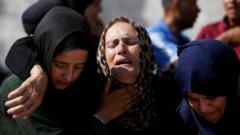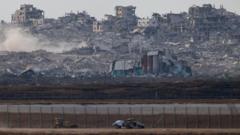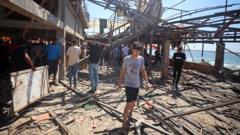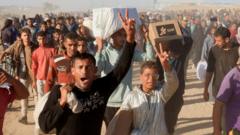A recent report by a former security contractor details incidents of guards allegedly firing on unarmed Palestinians at Gaza Humanitarian Foundation aid sites. Despite the contractor's claims, the GHF categorically denies these allegations, asserting that no civilians were harmed at their distribution centers.
Allegations of Violence at GHF Gaza Aid Distribution Sites
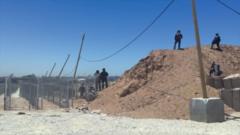
Allegations of Violence at GHF Gaza Aid Distribution Sites
A former contractor accuses the Gaza Humanitarian Foundation of employing excessive force against aid seekers, while the foundation denies the claims.
A former security contractor for the Gaza Humanitarian Foundation (GHF) has brought to light troubling allegations of violence occurring at aid distribution sites. The contractor, who requested anonymity, stated in an interview with the BBC that he witnessed colleagues opening fire on unarmed Palestinians seeking food assistance, including using machine guns against civilians.
One particular incident described involved a guard firing from a watchtower at a group of women, children, and elderly civilians who were reportedly moving too slowly away from the distribution site. In a separate occurrence, the contractor recounted an exchange between guards that followed a shooting, where they joked about hitting a Palestinian man who had fallen motionless to the ground.
When approached for a response, the GHF dismissed the accusations, labeling them as "categorically false." They asserted that no civilians had been fired upon at their sites and attributed the former contractor's claims to his dissatisfaction following termination for misconduct—a point the contractor disputed, providing evidence of continued payments after his departure.
The GHF began its aid distribution operations in Gaza after an 11-week blockade, during which essential supplies were entirely cut off from the territory. Despite criticisms that the aid distribution process forces individuals to traverse active combat areas, the GHF argues that its system prevents Hamas from exploiting humanitarian aid.
The contractor's account paints a grim picture of the conditions at these distribution sites. He described a lack of rules governing engagement, with one team leader advising guards to "shoot to kill and ask questions later" if they felt threatened. He asserted that the absence of oversight contributed to a culture of impunity, leading guards to act recklessly in their interactions with civilians.
Additionally, the contractor reported instances of harm from crowd control measures, such as being hit by debris from stun grenades and being sprayed with mace. In one case, he described a woman being struck in the head with metal debris from a stun grenade, leaving her unconscious on the ground.
Calls for the GHF to be disbanded have grown louder, with more than 170 NGOs—including Oxfam and Save the Children—demanding an end to its operations. These groups cite overwhelming evidence of Israeli forces and armed groups routinely firing upon Palestinians seeking aid. However, Israel refutes assertions that its military intentionally targets aid seekers, arguing that the GHF's structure enables direct humanitarian assistance while circumventing Hamas' interference.
Currently, the GHF claims to have delivered over 52 million meals within just five weeks, emphasizing the urgent need for aid in light of the ongoing humanitarian crisis precipitated by the Israel-Hamas conflict. This program unfolds against a backdrop of intense violence, with over 57,000 reported deaths in Gaza since the escalation of hostilities following the October 7 attack on Israel by Hamas.



